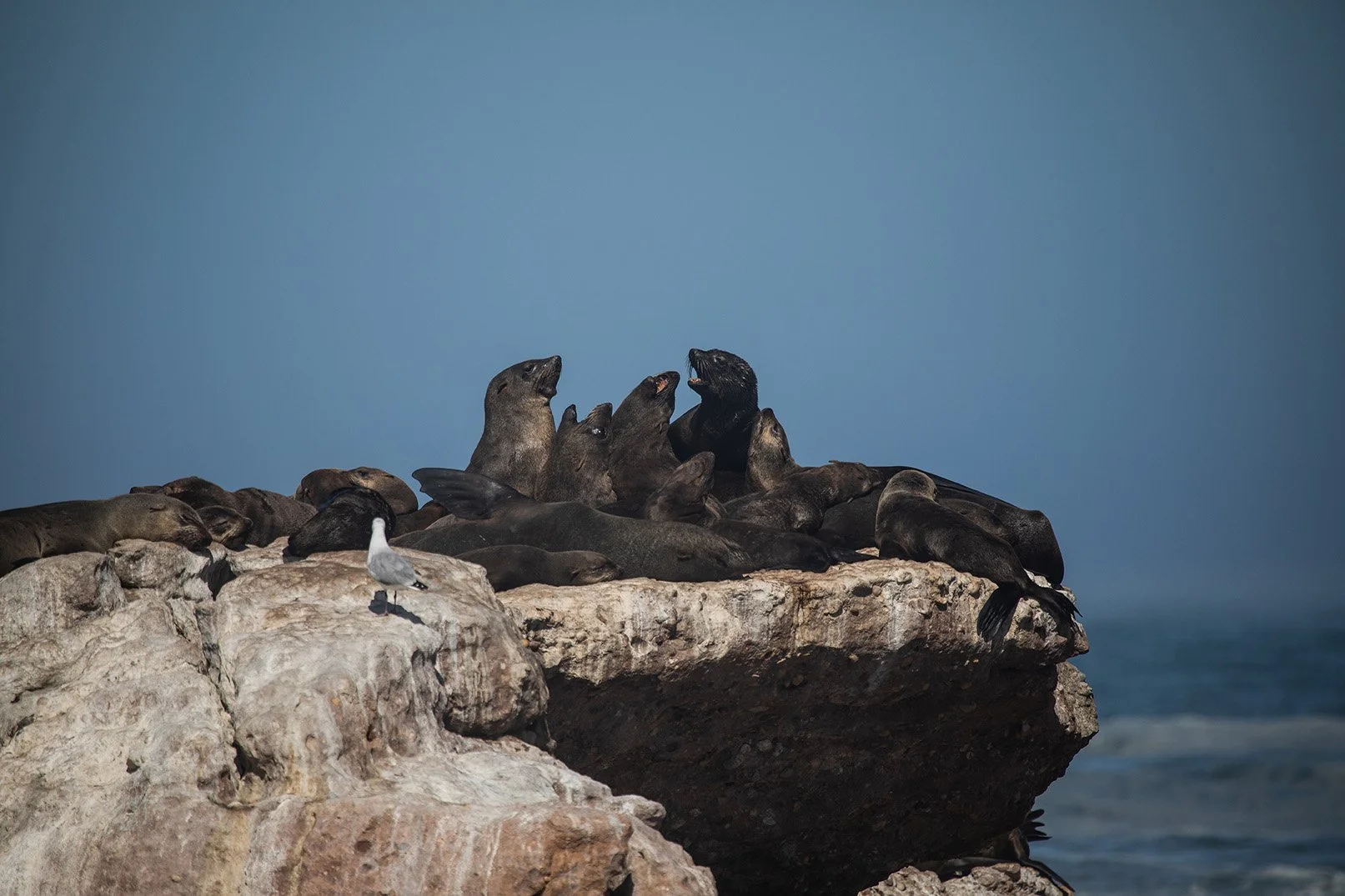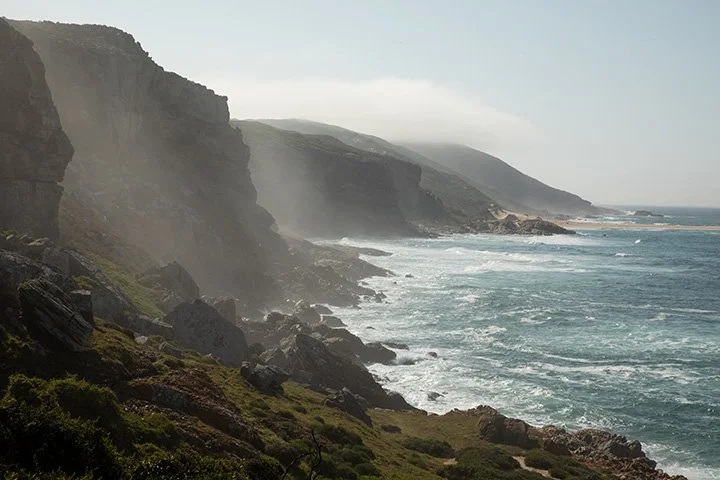A night around the braai, from 3,000 years ago
An intimate portrait emerges of a San hunter-gatherer clan from about 3,000 years ago, whose favourite haunt was a peninsula that juts into Plettenberg Bay. After almost five decades of breaking new ground in the field, pioneering African archaeologist Professor Judith Sealy recounts a story that remains close to her heart.
Written by: Leonie Joubert
Photographs by: Sam Reinders





An average night around the campfire for the Robberg clan might well have meant lounging at the mouth of a cave, with a clear view of the stars on mats made of vegetation collected from the nearby slopes. Not woven mats, but probably pressed and clumped together in the way that wool fibres become felt. The people around the fire might have sucked on the oily ribs of a seal or picked some fish bones from a nicely braaied piece of yellowtail which they probably caught by luring them close to shore with chum, or maybe even corralling them into a tidal pool.
The group probably weren’t settled here permanently but judging by the sheer number of seal and fish bones they’d tossed aside over many generations of dinners; it really was a favourite haunt.
There’s a most intriguing portrait that Professor Judith Sealy paints of this clan — the word ‘family’ isn’t correct here, by archaeology terms, because that would imply marriage between close relatives, and there are no genetic abnormalities in the found skeletons to suggest this happened. Sealy has good reason to believe that this clan didn’t like to hang out with their nearest neighbours much, who were only 14 km away at Keurbooms River mouth which can’t have been more than a day’s walk away.
The middens at the Robberg Nature Reserve near present-day Plettenberg Bay — basically, the archaeological remains of the family’s kitchen waste pile that are ancient but not fossilised— are a trove of secrets which Sealy and other archaeologists have studied for decades.
Sealy is on the threshold of retirement when she recounts the significance of this site from a comfortable chair in her office in the UCT Archaeology Department, where she has held a position as research chair in Stable Isotopes, Archaeology and Palaeo-environmental Studies since 2013. Sealy started her archaeology career as an undergraduate in the same department in 1978.
She is modest about the extent of her contribution to the field, but in the past five decades she has pioneered new methods of study that have blown wide open a previously limited understanding of how complex ancient hunter-gatherer societies in South Africa were responsive to different environments, and how varied their diets were depending on where they were able to find food.
Sealy has pioneered research methods that over the years have drawn environmental sciences and isotope studies into traditional archaeological methods.
Applying stable isotope analysis to human and animal remains has allowed researchers to reconstruct the diets of early African populations. Sealy’s work using these methods has, in particular, shown that San and Khoekhoe populations in southern Africa lived more varied lifestyles than previously thought, and that there was a marked difference between those foraging inland, compared with those along the coastline. Coastal communities relied heavily on marine food sources, and the Robberg group was unique in a most intriguing way.
The secrets held in the teeth and bones
The Robberg clan portrait shows just how closely modern-day archaeology can zoom in on the minutiae of a community this small.
We can’t say for sure how large the extended group was, says Sealy, but there are nevertheless plenty of secrets held within the carbon and nitrogen in the bones and teeth of skeletons found at the peninsula that have allowed her to paint the intimate portrait that she does.
The radioactive carbon isotopes (carbon-14) reveal that the skeletons of individuals buried on the Robberg Peninsula, or in the area known today as Plettenberg Bay, lived between about 4,500 and 2,000 years ago, explains Sealy.
The nitrogen isotopes (nitrogen-14 and nitrogen-15) hold the key to understanding what this group were eating, which pulls back the veil on another secret — the intriguing detail about their relationship with their neighbours.
Bone samples taken from the skeletons show that the Robberg Peninsula clan ate a few foods that were notably different to what archaeologists regard as the normal south coast diet. Most coastal dwellers at the time ate a mix of food foraged from the land, as well as from the tideline. The nitrogen isotopes show that the Robberg clan ate sea-gathered protein such as mussels and other shellfish, just as other coastal communities did, with the occasional fish caught in an estuary or lagoon. On the odd occasion that they found a stranded seal on a beach, or a dead one washed up, they may have eaten this too.
But the Robberg clan clearly ate a lot of seal and fish, particularly yellowtail. These two species are high in the marine food chain, and the kind of nitrogen isotope that percolates up to this apex position clearly shows in this group’s bone tissue.
These nitrogen isotope signatures confirm the physical evidence found at the Robberg middens — the discarded bones of yellowtail and seals.
‘The Robberg Peninsula is unique for the south coast geography. Sticking so far out into the sea means it was, and still is, host to a rare mainland seal colony, because the relatively inaccessible nature of the peninsula offers the seals some protection from land-based predators. Similarly, it offers unusually rich fishing opportunities. The ancient inhabitants of Robberg made the most of these opportunities, and we can see this recorded in their skeletons,’ says Sealy.
Isotopes found in ancient bones — be it carbon, nitrogen, oxygen, or strontium, amongst others — record a person’s diet throughout their full lives, as bone tissue is constantly being added to and replaced.
Isotopes in teeth, however, show someone’s diet during the years in which those specific teeth developed in their childhood.
When Sealy put tooth samples from the Robberg skeletons through stable light isotope analysis to see what kind of nitrogen lay there, it showed that during their younger years, the Robberg people had also eaten this seal- and yellowtail-intense diet.
Their isotopic makeup suggests that they weren’t seeking out marriage partners from nearby clans, such as those at the Keurbooms, but were marrying within their group.
‘It’s been a privilege to be able to work in this fascinating field, combining field-based archaeology and lab-based chemistry,’ says Sealy, reflecting on the archaeological lineage she has contributed to.
There is still a huge amount to learn though.
‘People have lived in South Africa for much longer than most other parts of the world. Most of this history pre-dates any written records, so investigations such as these are key in reconstructing the long-term story of our past.’
Gender-based violence is as old as we are
A smashed skull found with a 2,000-year-old skeleton, or a rib with marks suggesting that the person had been gravely injured with a bone-tipped weapon — the implement may even have snapped off and become trapped in the rib — are the telltale signs that even in pre-colonial times, people got into squabbles. Some of these could be lethal.
Maybe it was in defending a territorial boundary, or the food resources held within those boundaries. There could be many reasons why different clans might not be able to work out a dispute with diplomacy, and might come to blows. Professor Judith Sealy and colleagues have revealed that pre-colonial people were not peaceniks. Like most human communities, they sometimes resorted to violence.
In many of the recovered skeletons, it was clear that the overwhelming victims of this violence were women and children.

